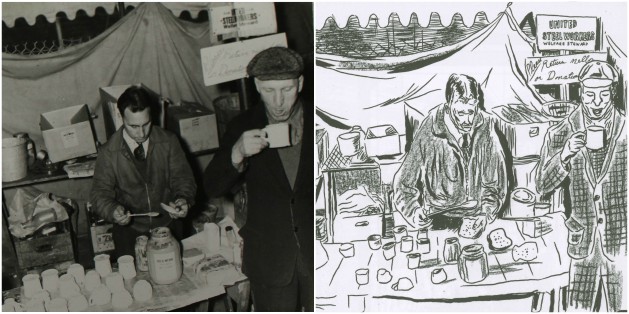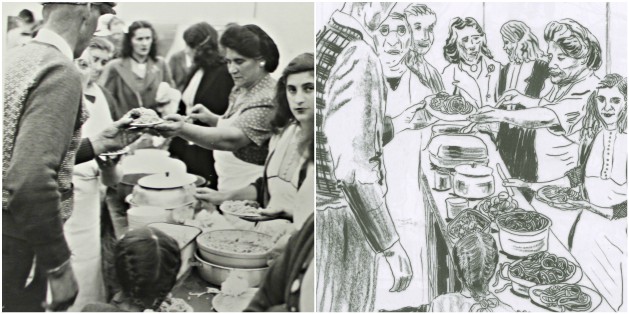McMaster maps and archives help shed light on “pivotal point” in Hamilton’s history

In 1946, 13,000 Hamilton workers went on strike– the largest in the city’s history. A new graphic novel a new graphic novel explores this tumultuous time with the help of materials from McMaster’s archives and maps collections. Image from: Showdown!: Making Modern Unions by Rob Kristofferson and Simon Orpana, (Between the Lines, 2016). Used with permission.
BY Naeema Bawa
January 16, 2017
The year is 1946. 13,000 Hamilton workers are on strike. Once quiet neighbourhoods in the city’s east end are now teeming with striking workers carrying picket signs, fighting for a better life.
It was the largest strike in Hamilton’s history and now this tumultuous time has been recreated in, Showdown! Making Modern Unions, written by Rob Kristofferson and Simon Orpana, a graphic novel created with the help of materials from McMaster’s archives and maps collections.
“It is important to remember the rights and society that people fought so hard for during the 20th century,” says Kristofferson, co-author and associate professor, History and Society, Culture & Environment at Wilfred Laurier University*. “In Canada, one of the epicentres of these struggles—a pivotal point that galvanized the structures that workers had been fighting for decades—happened in Hamilton.”
On July 15, 1946, thousands of Stelco steelworkers, many of whom were veterans recently returned from World War II, walked out on their jobs, demanding, among other things, a 40-hour workweek, higher wages and better benefits. It wasn’t long before they were joined by workers from Firestone, Westinghouse, and The Hamilton Spectator and by mid-summer, nearly 20 per cent of the city’s industrial workforce was on strike.
To help tell the story of this seminal event in Hamilton’s history, Kristofferson and Orpana turned to McMaster’s William Ready Division of Archives and Research Collections and Lloyd Reeds Maps Collection, which together, house extensive labour studies collections and historical maps from the period.
“In searching for photographic references and other means of telling this story in a graphic format, I spent a lot of time in the McMaster archives, which was a treasure trove of material that helped to bring this event from seventy years ago alive in a material way,” says Orpana, an artist and scholar who co-authored and illustrated the novel.**
From photographs and newspaper articles, to transcripts of radio broadcasts and letters, Kristofferson and Orpana used a wide range of materials, including first-hand accounts of the strike from the Library’s United Steelworkers Local 1005, Westinghouse Canada, United Electrical, Radio and Machine Workers collections, and using the archives of Pat Kelly – the public relations specialist hired by Stelco during the strike.
Rick Stapleton, Archives and Research Collections Librarian at McMaster, guided Orpana through the extensive collections of archive materials.
“The documents and materials provide evidence of what actually occurred at the time,” says Stapleton. “Simon actually wrote the archives department right into the book by portraying our reading room and items from our collection—the book very literally displays the importance of archives in the writing of history.”
Kristofferson and Orpana also worked with Gord Beck, Map Specialist in McMaster’s Maps, Data and GIS department, to learn more about the setting of the strike and the communities in which it took place.
“Simon and I looked at a wide range of materials from old road maps and city neighbourhood plans to aerial photographs and fire insurance plans from the 1940s,” he says. “They were necessary for him to be able to visualize the narratives coming from the eyewitness accounts and to be able to accurately place the people and events. The neighbourhood and fire insurance plans are so detailed, in fact, that they show the footprint of every building, whether it be house, store or factory.”
McMaster University Library is home to a number of archival collections that document the history of organized labour, many with a Hamilton connection– collections that Associate University Librarian Wade Wyckoff says can shed light on our collective past.
“Connecting students, researchers and the community-at-large with our unique collections is an important part of the Library’s mission,” says Wade Wyckoff, Associate University Librarian. “Rob and Simon’s work highlights the creative ways in which both archives and geographic resources can be used. I’m very pleased that we could contribute to this new telling of an important story that continues to resonate in our community and had lasting impacts well beyond Hamilton.”
Visit http://archives.mcmaster.ca to search archival and manuscript material held at the William Ready Division of Archives and Research Collections.
McMaster’s digital collection of archives, maps and rare books can be accessed and explored by students and researchers worldwide.
Photos from McMaster’s labour studies collections inspired the illustrations for Showdown!: Making Modern Unions. See below:



*Rob Kristofferson is also Coordinator of the Work & Employment Program at Wilfred Laurier University in Brantford, Ontario. He has worked on multiple projects with the Workers’ Arts & Heritage Centre in Hamilton since it opened in 1995.
**Simon Orpana is an artist and scholar with a PhD in English and Cultural Studies from McMaster University. He is currently a SSHRC Postdoctoral Fellow at the University of Alberta’s Department of English and Film Studies.

